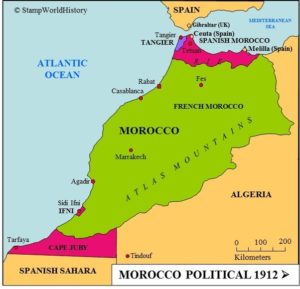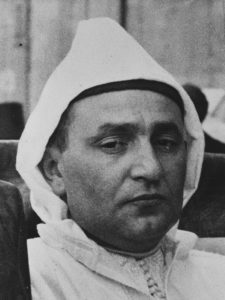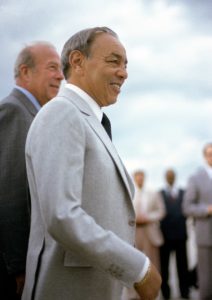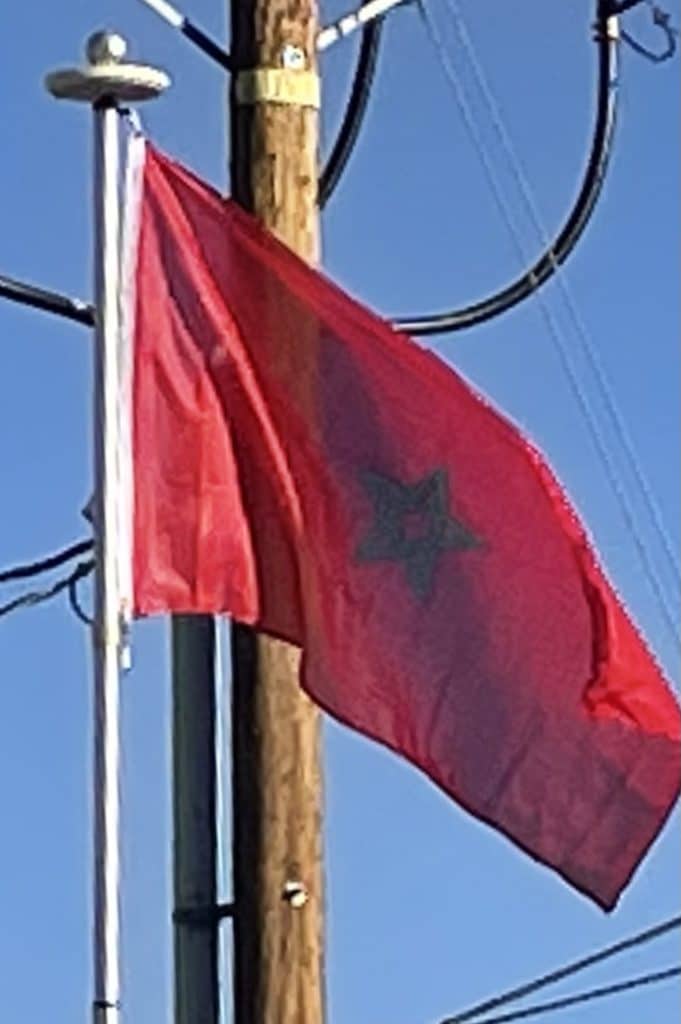In 1904, France and Spain carved out zones of influence in Morocco.

Tens of thousands of colonists entered Morocco. Some bought up large amounts of the rich agricultural land, others organised the exploitation and modernisation of mines and harbours. The institution of slavery was abolished in 1925.
In 1943, the Istiqlal Party (Independence Party) was founded to press for independence, with discreet US support. That party subsequently provided most of the leadership for the nationalist movement.
France’s exile of Sultan Mohammed V in 1953 to Madagascar and his replacement by the unpopular Mohammed Ben Aarafa sparked active opposition to the French and Spanish protectorates.

The most notable violence occurred in Oujda where Moroccans attacked French and other European residents in the streets. France allowed Mohammed V to return in 1955, and the negotiations that led to Moroccan independence began the following year. In March 1956 the French protectorate was ended and Morocco regained its independence from France as the “Kingdom of Morocco”. A month later Spain forsook its protectorate in Northern Morocco to the new state but kept its two coastal enclaves (Ceuta and Melilla) on the Mediterranean coast which dated from earlier conquests. Sultan Mohammed became king in 1957.
Post-independence:
Upon the death of Mohammed V, Hassan II became King of Morocco on 3 March 1961. Morocco held its first general elections in 1963. However, Hassan declared a state of emergency and suspended parliament in 1965. In 1971, there was a failed attempt to depose the king and establish a republic. A truth commission set up in 2005 to investigate human rights abuses during his reign confirmed nearly 10,000 cases, ranging from death in detention to forced exile. Some 592 people were recorded killed during Hassan’s rule according to the truth commission.

The Spanish enclave of Ifni in the south was returned to Morocco in 1969. The Polisario movement was formed in 1973, with the aim of establishing an independent state in the Spanish Sahara. On 6 November 1975, King Hassan asked for volunteers to cross into the Spanish Sahara. Some 350,000 civilians were reported as being involved in the “Green March“. A month later, Spain agreed to leave the Spanish Sahara, soon to become Western Sahara, and to transfer it to joint Moroccan-Mauritanian control, despite the objections and threats of military intervention by Algeria. Moroccan forces occupied the territory.
Moroccan and Algerian troops soon clashed in Western Sahara. Morocco and Mauritania divided up Western Sahara. Fighting between the Moroccan military and Polisario forces continued for many years. The prolonged war was a considerable financial drain on Morocco. In 1983, Hassan cancelled planned elections amid political unrest and economic crisis. In 1984, Morocco left the Organisation of African Unity in protest at the SADR‘s admission to the body. Polisario claimed to have killed more than 5,000 Moroccan soldiers between 1982 and 1985.
Algerian authorities have estimated the number of Sahrawi refugees in Algeria to be 165,000. Diplomatic relations with Algeria were restored in 1988. In 1991, a UN-monitored ceasefire began in Western Sahara, but the territory’s status remains undecided and ceasefire violations are reported. The following decade saw much wrangling over a proposed referendum on the future of the territory but the deadlock was not broken.
